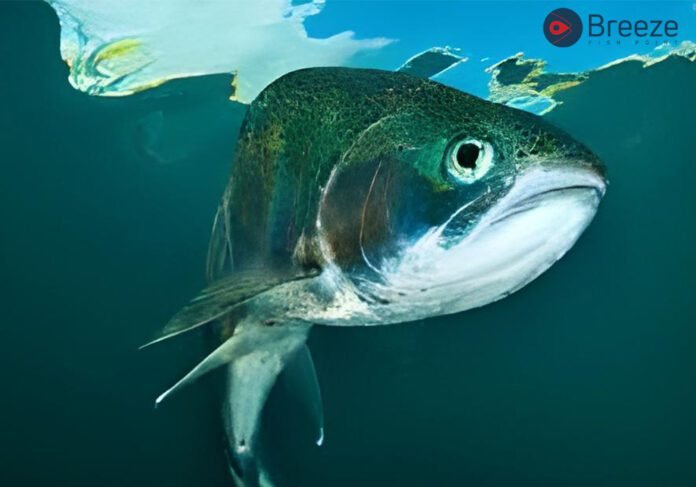The Rawas fish (also known as Indian Salmon, scientific name: Eleutheronema tetradactylum) is one of the most prized edible fish found in South Asia. But have you ever wondered what lies beneath those glistening scales? Whether you’re a curious angler, a marine biology enthusiast, or a student, understanding fish anatomy opens a fascinating window into aquatic life.
Fish may seem simple, but their internal systems are marvels of evolution — every fish body part, from fins to gills, plays a crucial role in survival. Let’s dive deep into the structure of fish, uncovering everything from their external anatomy to the unseen fish organs hidden inside.
Table of Contents
What Is the External Anatomy of Fish?
The external anatomy of fish includes all visible parts that interact with the surrounding environment. Here’s what you see from the outside:
- Head: Contains eyes, mouth, nostrils, and operculum (gill cover)
- Body: Covered in scales and mucus layer for protection
- Lateral Line: A sensory system that detects movement and vibration in the water
- Fins: Help with movement, stability, and direction
Key External Fish Parts:
- Dorsal Fin
- Pectoral Fin
- Pelvic Fin
- Anal Fin
- Caudal (Tail) Fin
- Mouth and Nostrils
Eyes and Operculum (gill cover)

What Are the Internal Organs of a Fish?
The internal anatomy of the fish reveals the hidden machinery of aquatic life. Most fish have a similar set of internal organs that perform essential life functions.
Key Internal Fish Organs:
- Brain: Controls bodily functions
- Heart: Usually two-chambered, pumps blood
- Liver: Detoxifies and stores energy
- Kidneys: Regulate water and salt balance
- Stomach and Intestines: Digest food
- Swim Bladder: Helps fish maintain buoyancy
- Gonads: Responsible for reproduction

How Do Fish Gills Work in Breathing Underwater?
Unlike humans, fish don’t have lungs — they rely on gills to extract oxygen from water.
Anatomy of Fish Gills:
- Located under the operculum (gill cover)
- Composed of thin filaments with rich blood supply
- Water flows over gill filaments and oxygen diffuses into the blood
- Carbon dioxide is expelled back into the water
The gill structure is extremely efficient, allowing fish to survive in low-oxygen environments.
What’s the Purpose of Fish Fins — And How Many Do They Have?

Anatomy of Fish Fins:
Fin Type | Location | Purpose |
Dorsal Fin | Top of the body | Stability during swimming |
Caudal Fin | Tail | Propulsion |
Pectoral Fins | Sides | Steering and balance |
Pelvic Fins | Below pectorals | Braking, turning |
Anal Fin | Near anus | Stability |
Do Fish Have Livers, Kidneys, or a Heart?
Yes, fish do have livers, kidneys, and hearts, though their structure and function can differ from mammals.
Key Organs Explained:
- Liver: Aids digestion, detoxifies blood
- Kidneys: Regulate bodily fluids and excrete waste
- Heart: Two chambers (atrium and ventricle), pumps blood to gills and rest of the body

How Is the Body of a Fish Structured Differently Than Mammals?
The structure of fish is uniquely suited for aquatic life. Key differences:
- Streamlined shape for efficient swimming
- Scales and mucus layer for protection
- Cold-blooded metabolism
- Swim bladder instead of lungs
- Lateral line for detecting vibrations
These adaptations enable fish to thrive in water — a medium with vastly different physics than air.
Can We Visualize It? (Fish Anatomy Diagram Table)
External Parts | Internal Organs |
Dorsal Fin | Brain |
Caudal Fin | Heart |
Pectoral Fins | Liver |
Pelvic Fins | Kidneys |
Anal Fin | Stomach/Intestine |
Mouth | Swim Bladder |
Operculum (Gill Cover) | Gonads |
Lateral Line | Digestive System |
FAQs: Common Questions About Fish Anatomy
Q1: Do fish have livers?
Q2: Do fish have kidneys?
Q3: Do fish have lungs?
Q4: What are the major parts of a fish?
Q5: What is the difference between internal and external anatomy of fish?
Final Thoughts: Why Knowing Fish Anatomy Matters
Understanding the anatomy of fish isn’t just for biologists — it’s useful for fishermen, aquarium hobbyists, students, and even chefs. Whether you’re studying marine life or just curious about what lies inside fish, this knowledge enhances your connection with the aquatic world.
From the mighty Rawas fish to tiny tetras, the complexity of fish anatomy reminds us of the beauty and brilliance of nature’s engineering.




